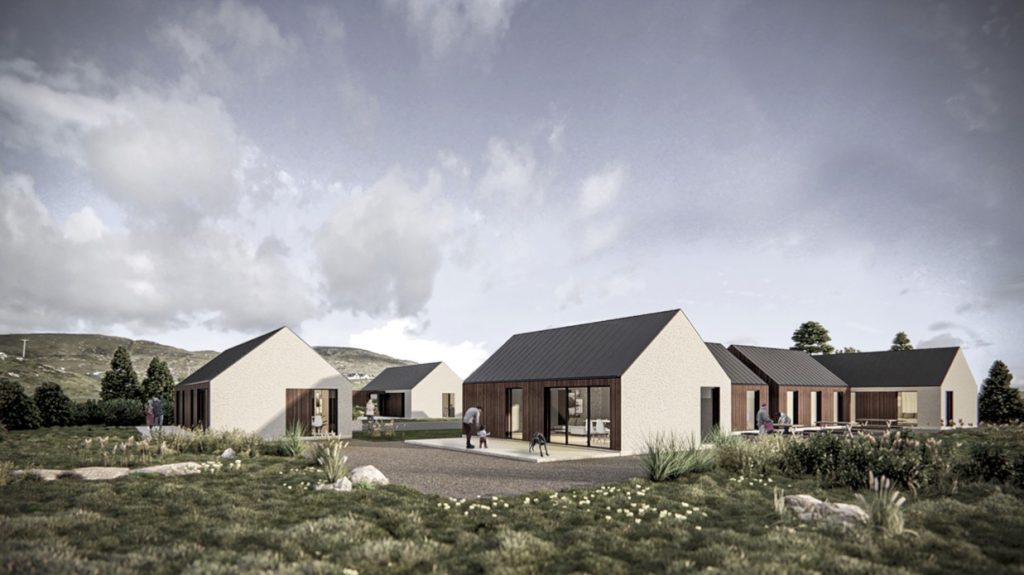Sam Foster is an architect working with Architype. His experience includes six years at Gaia Architects, nine years running his own practice and two years at Rural Housing Scotland as project manager for community-led affordable housing projects in rural Scotland – all of which focused on low-energy design using natural, non-toxic and low embodied carbon construction materials. He has lectured at several universities in Scotland and given talks to industry and the public on a wide range of ecological design aspects, including building health, energy efficiency and natural materials.
The UK is building houses like it’s still the 1960s.
Whether in cities, towns or villages, we lay them out, Toy Town style, often in joyless, mono-functional ‘estates’, devoid of richness and located away from schools, shops and places to have fun.
We prioritise the movement of cars over people and ignore orientation, often putting car parking in the sunniest part of what would have made a nice garden or sunroom.
We construct them poorly, for the lowest cost, from polluting materials that are known to be harmful to human health and the environment.
We build in a way that is exceptionally wasteful of materials, where both the building process and the completed homes contribute hugely to climate change.
And then we sell them to the highest bidder, for the greatest profit, hoping they won’t spot the problems before any period of responsibility has run out.
Occupants are left with draughty, poorly insulated, uninspiring and dark houses that make them feel unwell and isolated, and despite us spending 92% of our time inside, we don’t regularly check them in any way to make sure they’re fit to live in.
This is legal, and it is normal in the UK. It has been fuelled by government policy and private greed for over forty years, but it is changing. We are seeing the slow but consistent growth of positive, alternative ways of building that expand on the aspirations of some amazing single houses and community-led affordable housing projects; that prioritise health and wellbeing without being expensive; that are built by groups of people in awkward but enriching locations, who invest sweat and care into creating a place with a feeling of belonging.
Those people range from organisations such as forward-looking Housing Associations and Councils to groups of people with a firm belief that something better must be possible. Taking this leap involves stepping out of the ‘normal now’ train of thought and deciding – intentionally – to do something different, to make a ‘new normal’ that begins at first principles.
They become beautiful places that people want to live in.
By doing this, councils such as Exeter, Housing Associations such as Fairfield and Hastoe, and build-groups like those at LILAC in Leeds have created housing that is good for people and the planet. They are bright, comfortable, big enough, inclusive, joyful, affordable to live in – and affordable to build. They improve occupants’ health and help reduce the risk of isolation and ill health in the first place – reducing the cost of NHS care and medication. They become beautiful places that people want to live in.
Scotland needs to see the widespread development and delivery of transformative housing projects like these – and the best place to start is in rural and island areas. After all, if they can work here – where weather, workforce, sites and materials pose the greatest physical and financial challenges – then they can almost certainly work in urban areas.
Some projects are already underway, such as Hope Co-Housing (a co-housing project in Orkney for older women), Braemar Community Housing (community-led affordable housing for rent) and Smart Clachan. These have lots of things in common but three factors stand out as being particularly critical to their sustainability:
- They all take the climate and biodiversity crises seriously by being built from low-carbon materials to extremely high levels of energy efficiency;
- As such they all require very little energy to keep them warm, helping future tenants to avoid the risk of fuel poverty, and;
- They are all being directly developed by the communities whose residents will ultimately live in them, meaning they have a vested interest in making sure they’re of the best possible quality.

Decarbonising the national grid (which many are calling loudly for) is important – but will make absolutely no difference to the amount of energy needed to keep a house warm, especially in rural and island communities where it’s common to experience much colder temperatures and more wind chill than urban areas. Reducing energy demand, by insulating and draught-proofing homes using natural and renewable materials, is a no-brainer.
‘Who pays for it?’ I hear you cry. That’s a good question, and one that policy think-tank Common Weal has pondered in great detail in its ‘Our Common Home’ campaign. And there are other enormous issues for us to face too, such as how to make land ownership fairer so that we can actually build the homes we need, and how to move away from the tendency to see our homes as money-making assets.
People want to live in homes that are good for them and the planet, and which are built in places they have a connection with. While the Scottish Government’s Housing to 2040 strategy has attempted to make achieving this easier, it fails to offer any real guidance for how to do this as a community. Giving communities control over how and where the homes they need are built – with appropriate planning controls – makes a lot of sense. Making this happen, though, relies on good deal of well-organised communication and support, which Rural Housing Scotland called for in its manifesto for the 2021 Scottish Parliament elections. This would be a good starting point for many of the current crop of ministers!
